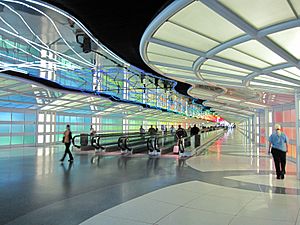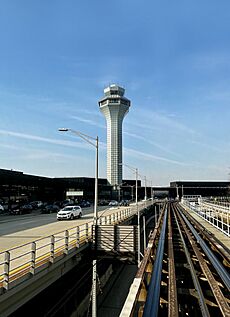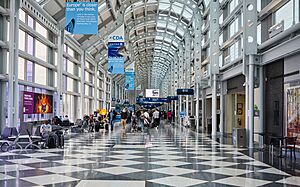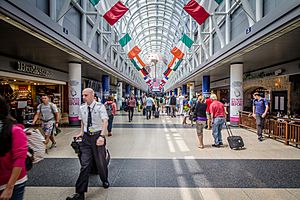O'Hare International Airport facts for kids
Quick facts for kids
Chicago O'Hare International Airport
|
|||||||||||||||||||||||||||||||||||||||
|---|---|---|---|---|---|---|---|---|---|---|---|---|---|---|---|---|---|---|---|---|---|---|---|---|---|---|---|---|---|---|---|---|---|---|---|---|---|---|---|
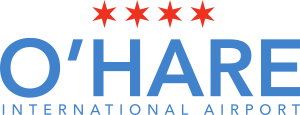 |
|||||||||||||||||||||||||||||||||||||||
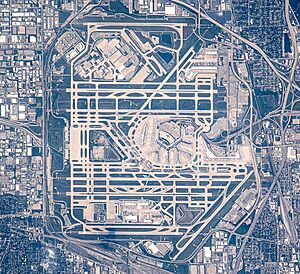
Satellite image of O'Hare in 2023
|
|||||||||||||||||||||||||||||||||||||||
| Summary | |||||||||||||||||||||||||||||||||||||||
| Airport type | Public | ||||||||||||||||||||||||||||||||||||||
| Owner/Operator | Chicago Department of Aviation | ||||||||||||||||||||||||||||||||||||||
| Serves | Chicago metropolitan area | ||||||||||||||||||||||||||||||||||||||
| Location | O'Hare, Chicago, Illinois, U.S. | ||||||||||||||||||||||||||||||||||||||
| Opened | February 1944 | ||||||||||||||||||||||||||||||||||||||
| Hub for | |||||||||||||||||||||||||||||||||||||||
| Focus city for | Polar Air Cargo | ||||||||||||||||||||||||||||||||||||||
| Time zone | CST (UTC−06:00) | ||||||||||||||||||||||||||||||||||||||
| • Summer (DST) | CDT (UTC−05:00) | ||||||||||||||||||||||||||||||||||||||
| Elevation AMSL | 204 m / 668 ft | ||||||||||||||||||||||||||||||||||||||
| Coordinates | 41°58′43″N 87°54′17″W / 41.97861°N 87.90472°W | ||||||||||||||||||||||||||||||||||||||
| Map | |||||||||||||||||||||||||||||||||||||||
FAA airport diagram |
|||||||||||||||||||||||||||||||||||||||
| Runway | |||||||||||||||||||||||||||||||||||||||
|
|||||||||||||||||||||||||||||||||||||||
| [[Helipad|]] | |||||||||||||||||||||||||||||||||||||||
|
|||||||||||||||||||||||||||||||||||||||
| Statistics (2024) | |||||||||||||||||||||||||||||||||||||||
|
|||||||||||||||||||||||||||||||||||||||
|
Source: O'Hare International Airport
|
|||||||||||||||||||||||||||||||||||||||
Chicago O'Hare International Airport is a huge airport that serves the city of Chicago, Illinois, in the United States. It's located about 17 miles (27 km) northwest of downtown Chicago. The airport is managed by the Chicago Department of Aviation and covers a massive area of 7,627 acres (3,086 hectares).
O'Hare offers direct flights to 249 places across North America, South America, the Caribbean, Europe, Africa, Asia, and the Middle East. In 2024, it was named the most connected airport in the U.S. and the fifth most connected in the world. It's also the world's fourth busiest airport.
This airport was planned to replace Chicago's Midway International Airport, which was once called the "busiest square mile in the world." O'Hare started as an airfield for a factory that built military transport planes during World War II. It was first called Orchard Field Airport. In 1949, it was renamed after Edward "Butch" O'Hare, a U.S. Navy pilot who received the Medal of Honor during the war.
O'Hare was one of the first major airports designed after World War II. It introduced new ideas like separate terminal areas (concourses), direct roads to the terminals, jet bridges (those walkways connecting the plane to the terminal), and underground fueling systems. These ideas are now used at airports all over the world.
During the "jet age," O'Hare was known as the world's busiest airport for passengers from 1963 to 1998. It's still one of the busiest airports today. In 2019, O'Hare had over 919,000 aircraft movements, which means about 2,520 planes took off or landed every day. This high number is partly because of many regional flights. You can get to the airport by shuttle, bus, the Chicago "L" train, or taxi. Interstate 190 goes right into the airport. O'Hare is a main hub for American Airlines and United Airlines.
Contents
History of O'Hare Airport
How the Airport Started
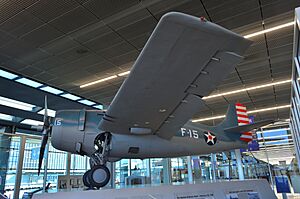
Chicago realized it needed a bigger airport soon after Chicago Municipal Airport opened in 1926. But not much happened until the U.S. entered World War II.
O'Hare began as a factory that built Douglas C-54 Skymaster planes during World War II. It was next to an airfield called Douglas Field. The area was originally a small farming community. The factory needed to be close to Chicago's workers and far from enemy threats. Over 650 C-54s were built there. The airfield had four runways, each about 5,500 feet (1,676 meters) long. This site also stored captured enemy aircraft.
After the war, the Douglas Company stopped using the site. The complex was then called Orchard (Douglas) Airport, and it got the airport code ORD. The only building left from the Douglas Aircraft Factory is now used by the City of Chicago's Department of Aviation.
The United States Air Force used the airfield a lot during the Korean War. It was a base for fighter planes. By 1960, as more commercial flights started, the Air Force moved its active units out. The site was then used for reserve and Air National Guard units. In 1997, the reserve base closed, and the land became part of the Chicago Department of Aviation.
Early Commercial Flights and Growth
In 1945, Chicago's mayor decided to find a spot for a new airport. They chose the Orchard Field site and bought most of the land from the government in 1946. The military kept a small part and could use 25% of the airfield for free.
A man named Ralph H. Burke created a new airport design. He came up with "split finger terminals," which are like fingers (concourses) sticking out from a main building. This design allowed for more gates and planes. His plan also included underground fueling, direct road access to terminals, and direct train access from downtown. These ideas are now common at airports worldwide. O'Hare was also the first airport to use a jet bridge in 1958.
In 1949, the city renamed the airport O'Hare Airport to honor Edward "Butch" O'Hare. He was the first U.S. Navy pilot to become a flying ace and receive the Medal of Honor in World War II. Even with the new name, the airport's code (ORD) stayed the same.
Regular passenger flights started in 1955, but it grew slowly at first. Airlines didn't want to move from Midway until O'Hare had better roads and other improvements. In 1958, O'Hare's first international terminal opened. By 1959, the airport had grown to 7,200 acres (2,914 hectares) with new buildings and parking. The expressway to downtown Chicago, now called the Kennedy Expressway, was finished in 1960. New Terminals 2 and 3 opened in 1962.
The biggest reason airlines moved to O'Hare was the new jet planes. Midway Airport was too small for the long runways that jets like the Boeing 707 needed. By July 1962, all scheduled airline flights in Chicago had moved from Midway to O'Hare. This quickly made O'Hare the world's busiest airport, serving 10 million passengers a year. Within two years, that number doubled. O'Hare remained the world's busiest airport until 1998.
Changes After Deregulation
In the 1980s, after new airline rules were passed, some airlines like TWA and Northwest moved their main hubs away from O'Hare. Delta also had a hub at O'Hare for a while, even building a new Concourse L in 1983. But eventually, Delta also moved its main operations elsewhere.
Today, United Airlines and American Airlines are the main airlines at O'Hare. United built a new Terminal 1 between 1985 and 1987. This terminal has 50 gates and is known for its curved glass design. It also has a cool underground tunnel between Concourses B and C, lit up with a neon art display called Sky's the Limit. American Airlines updated its facilities in Terminal 3 around the same time.
For a while, international flights used a "temporary" Terminal 4 in the parking garage. This changed in 1993 when the new 21-gate International Terminal (now Terminal 5) was finished. It has all the customs facilities. A special train system, the Airport Transit System, was built to connect the main terminals with Terminal 5 and other parking areas.
Since the late 1980s, O'Hare faced delays because its runway layout wasn't very efficient. The runways crossed each other, which could be dangerous and slow things down. In 2001, the Chicago Department of Aviation started a big plan called the O'Hare Modernization Plan (OMP). This plan aimed to completely change the airfield. It included building four new runways, making two existing ones longer, and closing three old ones. The goal was to have six parallel runways and two crosswind runways.
The OMP faced some challenges, including legal issues with nearby towns and even a cemetery that needed to be moved. These issues and a drop in air travel slowed down the project. The last parallel runway was finished in 2020, and an extension of another runway was completed in 2021, marking the end of the OMP.
Future Expansion Plans
In 2018, the city and airlines started a new plan called O'Hare 21. This plan includes building two brand new satellite concourses and expanding Terminals 2 and 5. Terminal 5 already has ten new gates and can handle very large planes like the Airbus A380.
The expansion will make it easier to transfer between international and domestic flights. It will also improve security checks and customs. A major part of the plan is to create an "alliance hub" by building the O'Hare Global Terminal (OGT) where Terminal 2 is now. This new terminal and the satellite concourses will help American and United Airlines work better with their partner airlines. This means passengers won't need to switch to Terminal 5 for international flights.
The project will add over 3 million square feet (278,709 square meters) to the airport's terminals. It will also add a new customs center in the OGT and increase the number of gates from 185 to 235. The new concourses will be wider, and there will be more space at each gate for larger aircraft. The total cost of the project is about $8.5 billion.
The O'Hare 21 project is expected to finish the two satellite terminals by 2028, with the whole project completed by 2030. In May 2024, American Airlines and United Airlines agreed with the City of Chicago to speed up the replacement of Terminal 2 with the OGT. The design for Satellite 1 concourse was shown to the public in May 2024, and it is planned to be finished by 2028.
Airport Facilities
Terminals for Passengers
O'Hare has four main passenger terminals with nine concourses and a total of 215 gates. This is the most gates of any airport in the world.
- Terminal 1 is mainly used by United Airlines, Lufthansa, and All Nippon Airways. It has 52 gates across two concourses, B and C.
- Terminal 2 is used for most United Express and some United flights. It also handles all Air Canada, Alaska Airlines, and JetBlue flights. It has 41 gates on concourses E and F.
- Terminal 3 is where American Airlines, Aer Lingus, British Airways, Iberia, Japan Airlines, and Spirit Airlines operate. It has 80 gates on four concourses: G, H, K, and L.
- Terminal 5 is for Delta Air Lines, Frontier Airlines, and Southwest Airlines. It also handles all other international airlines that don't use Terminals 1–3. This terminal has the airport's U.S. Customs and Border Protection facilities for international arrivals. It has 35 gates on Concourse M, including three gates that can fit the huge Airbus A380.
Terminals 1, 2, and 3 are connected by walkways inside the airport. Terminal 5 is separate. If you need to go between Terminal 5 and the other terminals, you can take a shuttle bus or the Airport Transit System train.
Runways at O'Hare
O'Hare has two groups of parallel runways, one on each side of the terminals. Each group has three parallel east-west runways and one crosswind runway. The airport has three FAA air traffic control towers to manage all the planes. O'Hare also has a program to reduce noise at night.
In 2015 and 2019, two older runways were closed. Currently, O'Hare has eight runways, which is the most of any civilian airport in the world.
Airport Hotel
The Hilton Chicago O'Hare is the only hotel right at the airport. It's located between the main terminals and the parking garage.
Getting Around the Airport
The Airport Transit System (ATS) takes passengers between Terminals 1–3, Terminal 5, and the O'Hare Multi-Modal Facility (MMF). This train system reopened in November 2021 after a long renovation. Free shuttle buses also run 24/7. The MMF is where you can find car rental companies and extended parking.
The CTA Blue Line train has a station at O'Hare. It provides direct service to downtown Chicago and runs 24 hours a day. The station is on the lower level of the parking garage.
Other bus services like Pace also stop at the MMF. O'Hare is also directly connected to Interstate 190, which links to other major highways.
Cargo Facilities
O'Hare has two main areas for cargo. The South Cargo Area was moved and rebuilt to make space for new runways. It has facilities for many airlines and shipping companies like FedEx and UPS.
The Northeast Cargo Area (NEC) used to be a military base. It's a new facility designed to increase O'Hare's cargo capacity by 50%. It has large buildings for warehouses. O'Hare shipped over 1.7 million tons of cargo in 2018, making it one of the busiest cargo airports in the U.S.
Other Cool Features
In 2011, O'Hare became the first major airport to have an apiary (a place for bees) on its property. Every summer, it has up to 75 beehives and a million bees. These bees are cared for by people learning new job skills. They turn the honey into products like bottled honey, soaps, and lip balms.
Airlines and Destinations
Passenger Flights
| Airlines | Destinations | Refs |
|---|---|---|
| Aer Lingus | Dublin | |
| Aeroméxico | Guadalajara, Mexico City | |
| Air Canada | Montréal–Trudeau, Toronto–Pearson, Vancouver | |
| Air Canada Express | Montréal–Trudeau, Toronto–Pearson | |
| Air France | Paris–Charles de Gaulle | |
| Air India | Delhi | |
| Air Serbia | Belgrade | |
| Alaska Airlines | Anchorage, Portland (OR), San Diego (begins October 4, 2025), San Francisco (ends August 20, 2025), Seattle/Tacoma | |
| All Nippon Airways | Tokyo–Haneda, Tokyo–Narita | |
| American Airlines | Albuquerque, Atlanta, Austin, Boston, Cancún, Charlotte, Cleveland, Dallas/Fort Worth, Denver, Des Moines, Fort Lauderdale, Fort Myers, Grand Rapids, Hartford, Honolulu (resumes October 26, 2025), Houston–Intercontinental, Indianapolis, Kansas City, Las Vegas, London–Heathrow, Los Angeles, Mexico City (resumes October 26, 2025), Miami, Minneapolis/St. Paul, Montego Bay, New Orleans, New York–JFK, New York–LaGuardia, Newark, Orange County (CA), Orlando, Philadelphia, Phoenix–Sky Harbor, Punta Cana, Raleigh/Durham, Sacramento, St. Louis, Salt Lake City, San Antonio, San Diego, San Francisco, San José del Cabo, San Juan, Seattle/Tacoma, Spokane, Tampa, Tucson, Washington–National, West Palm Beach Seasonal: Anchorage, Aruba, Athens, Baltimore, Barcelona, Boise (begins August 6, 2025), Bozeman, Buffalo, Calgary, Charleston (SC), Cincinnati (begins August 6, 2025), Cozumel, Curaçao (begins December 6, 2025), Destin/Fort Walton Beach, Detroit, Dublin, Eagle/Vail, Glacier Park/Kalispell, Grand Cayman, Guatemala City (resumes November 6, 2025), Jackson Hole, Jacksonville (FL), Liberia (CR), Madrid, Memphis (begins August 14, 2025), Naples, Nashville, Nassau, Omaha, Palm Springs, Paris–Charles de Gaulle, Pittsburgh, Portland (OR), Providence, Providenciales, Puerto Vallarta, Querétaro (begins December 12, 2025), Rome–Fiumicino, St. Croix (begins December 6, 2025), St. Maarten (begins November 8, 2025), St. Thomas, San José (CR) (resumes November 2, 2025), Sarasota, Savannah, Vancouver |
|
| American Eagle | Akron/Canton (begins October 6, 2025), Albany, Appleton, Asheville, Aspen, Atlanta, Austin, Baltimore, Bangor, Birmingham (AL), Bismarck, Bloomington/Normal, Boise, Boston, Buffalo, Cedar Rapids/Iowa City, Champaign, Charleston (SC), Chattanooga (resumes October 6, 2025), Cincinnati, Cleveland, Colorado Springs, Columbia (MO), Columbus–Glenn, Dayton, Des Moines, Detroit, El Paso, Evansville, Fargo, Fayetteville/Bentonville, Flint, Fort Wayne, Grand Rapids, Green Bay, Greensboro, Greenville/Spartanburg, Harrisburg, Hartford, Huntsville, Indianapolis, Jacksonville (FL), Kalamazoo, Kansas City, Knoxville, La Crosse, Lansing, Lexington, Little Rock, Louisville, Madison, Manhattan (KS), Marquette, Memphis, Milwaukee, Minneapolis/St. Paul, Moline/Quad Cities, Mosinee/Wausau, Nashville, New Orleans, Newark, Norfolk, Oklahoma City, Omaha, Peoria, Pittsburgh, Providence, Raleigh/Durham, Rapid City, Richmond, Roanoke (begins August 6, 2025), Rochester (MN), Rochester (NY), St. Louis, Salt Lake City, Sioux Falls, Springfield (IL), Springfield/Branson, Syracuse, Toronto–Pearson, Traverse City, Tulsa, Waterloo (IA), White Plains, Wichita, Wilkes-Barre/Scranton Seasonal: Albuquerque, Billings, Bozeman, Burlington (VT), Calgary, Dallas/Fort Worth, Halifax, Hayden/Steamboat Springs, Hilton Head, Houston–Intercontinental, Hyannis, Idaho Falls (begins August 6, 2025), Key West, Manchester (NH), Martha's Vineyard, Missoula, Montréal–Trudeau, Myrtle Beach, Nantucket, Panama City (FL), Pensacola, Portland (ME), Québec City, Santa Fe (begins December 18, 2025), Sun Valley (begins December 18, 2025), Wilmington (NC) |
|
| Arajet | Punta Cana (begins November 15, 2025) | |
| Austrian Airlines | Vienna | |
| Avelo Airlines | Seasonal: New Haven | |
| Avianca | Bogotá | |
| Avianca Costa Rica | Seasonal: Guatemala City, San José (CR) | |
| Avianca El Salvador | Seasonal: San Salvador | |
| British Airways | London–Heathrow | |
| Cathay Pacific | Hong Kong | |
| Contour Airlines | Burlington (IA), Cape Girardeau, Fort Leonard Wood, Kirksville, Manistee, Marion, Owensboro Seasonal: Lewisburg (WV) |
|
| Copa Airlines | Panama City–Tocumen | |
| Delta Air Lines | Atlanta, Boston, Detroit, Los Angeles (begins June 7, 2026), Minneapolis/St. Paul, New York–LaGuardia, Salt Lake City, Seattle/Tacoma | |
| Delta Connection | New York–JFK, New York–LaGuardia | |
| Denver Air Connection | Dubuque, Ironwood, Jackson (TN), Muskegon, Watertown (SD) (ends August 1, 2025) | |
| Emirates | Dubai–International | |
| Ethiopian Airlines | Addis Ababa | |
| Etihad Airways | Abu Dhabi | |
| EVA Air | Taipei–Taoyuan | |
| Finnair | Seasonal: Helsinki | |
| Frontier Airlines | Atlanta, Austin, Cancún, Charlotte, Dallas/Fort Worth, Denver, Fort Myers, Houston–Intercontinental, Las Vegas, Los Angeles, Nashville, Orlando, Philadelphia, Phoenix–Sky Harbor, Punta Cana, Salt Lake City, San Diego, Sarasota, Tampa, West Palm Beach Seasonal: Baltimore |
|
| Iberia | Madrid | |
| Icelandair | Reykjavík–Keflavík | |
| ITA Airways | Seasonal: Rome–Fiumicino | |
| Japan Airlines | Tokyo–Haneda, Tokyo–Narita | |
| JetBlue | Boston, New York–JFK | |
| KLM | Amsterdam | |
| Korean Air | Seoul–Incheon | |
| LOT Polish Airlines | Kraków, Warsaw–Chopin | |
| Lufthansa | Frankfurt, Munich | |
| Qatar Airways | Doha | |
| Royal Jordanian | Amman–Queen Alia | |
| Scandinavian Airlines | Copenhagen | |
| Southern Airways Express | Quincy, West Lafayette | |
| Southwest Airlines | Austin, Baltimore, Cancún, Dallas–Love, Denver, Las Vegas, Nashville, Orlando, Phoenix–Sky Harbor | |
| Spirit Airlines | Baltimore, Cancún, Dallas/Fort Worth, Fort Lauderdale, Fort Myers, Houston–Intercontinental, Las Vegas, Los Angeles, Miami, Nashville, New Orleans, New York–LaGuardia, Newark, Orlando, San Juan, Tampa Seasonal: Myrtle Beach, Phoenix–Sky Harbor |
|
| Sun Country Airlines | Minneapolis/St. Paul | |
| Swiss International Air Lines | Zurich | |
| TAP Air Portugal | Lisbon | |
| Turkish Airlines | Istanbul | |
| United Airlines | Albany, Albuquerque, Amsterdam, Aruba, Atlanta, Austin, Baltimore, Boston, Bozeman, Brussels, Buffalo, Burlington (VT), Calgary, Cancún, Cedar Rapids/Iowa City, Charleston (SC), Charlotte, Cincinnati, Cleveland, Columbus–Glenn, Dallas/Fort Worth, Denver, Des Moines, Detroit, Dublin, Fort Lauderdale, Fort Myers, Frankfurt, Grand Rapids, Guatemala City, Harrisburg, Hartford, Honolulu, Houston–Intercontinental, Jacksonville (FL), Kahului, Kansas City, Las Vegas, London–Heathrow, Los Angeles, Madison, Memphis, Mexico City, Miami, Minneapolis/St. Paul, Montego Bay, Munich, Nashville, New Orleans, New York–LaGuardia, Newark, Norfolk, Omaha, Ontario, Orange County (CA), Orlando, Paris–Charles de Gaulle, Pensacola, Philadelphia, Phoenix–Sky Harbor, Pittsburgh, Portland (ME), Portland (OR), Puerto Vallarta, Punta Cana, Raleigh/Durham, Reno/Tahoe, Richmond, Rochester (NY), Sacramento, St. Louis, Salt Lake City, San Antonio, San Diego, San Francisco, San Jose (CA), San José del Cabo, San Juan, São Paulo–Guarulhos, Sarasota, Savannah, Seattle/Tacoma, Sioux Falls, Syracuse, Tampa, Tel Aviv (suspended), Tokyo–Haneda, Toronto–Pearson, Traverse City, Vancouver, Washington–Dulles, Washington–National, Wichita, Zurich Seasonal: Anchorage, Athens, Barcelona, Belize City, Boise, Colorado Springs, Cozumel, Dayton (begins September 25, 2025), Eagle/Vail, Edinburgh, Edmonton, Fairbanks, Fresno, Glacier Park/Kalispell, Grand Cayman, Green Bay (begins September 26, 2025), Greenville/Spartanburg, Hayden/Steamboat Springs, Indianapolis, Ixtapa/Zihuatanejo, Jackson Hole, Kailua-Kona, Key West, Knoxville, Liberia (CR), Milan–Malpensa, Missoula, Montréal–Trudeau, Montrose, Myrtle Beach, Nassau, Palm Springs, Panama City (FL), Providence, Providenciales, Rapid City, Reykjavík–Keflavík, Rome–Fiumicino, St. Lucia–Hewanorra, St. Maarten, St. Thomas, San José (CR), Shannon, Tucson, West Palm Beach, |
|
| United Express | Akron/Canton, Albany, Allentown, Appleton, Asheville, Billings, Birmingham (AL), Boise, Buffalo, Cedar Rapids/Iowa City, Charleston (SC), Charleston (WV), Charlottesville (VA), Chattanooga, Cincinnati, Cleveland, Colorado Springs, Columbia (MO) (resumes September 25, 2025), Columbia (SC), Columbus–Glenn, Dayton, Decatur, Des Moines, Detroit, Duluth, Eau Claire, El Paso, Fargo, Fayetteville/Bentonville, Flint, Fort Dodge, Fort Wayne, Grand Rapids, Green Bay, Greensboro, Greenville/Spartanburg, Gunnison/Crested Butte, Harrisburg, Houghton, Huntsville, Indianapolis, Johnstown (PA), Joplin, Kansas City, Knoxville, Lexington, Lincoln, Little Rock, Louisville, Madison, Mason City, Memphis, Milwaukee, Moline/Quad Cities, Monterrey, Montréal–Trudeau, Morgantown (WV), Nashville, New Orleans, Oklahoma City, Omaha, Ottawa, Peoria, Pittsburgh, Portland (ME), Providence, Richmond, Roanoke, Rochester (NY), Saginaw, St. Louis, Salina, Savannah, Sioux City, Sioux Falls, South Bend, Springfield/Branson, State College, Syracuse, Toronto–Pearson, Traverse City, Tucson, Tulsa, Watertown (SD) (begins August 1, 2025), West Lafayette (begins August 5, 2025), Wichita, Wilkes-Barre/Scranton, Winnipeg Seasonal: Albuquerque, Aspen, Bangor, Bozeman, Burlington (VT), Glacier Park/Kalispell, Great Falls, Halifax, Harlingen, Hartford, Hayden/Steamboat Springs, Hilton Head, Jacksonville (FL), Key West, Minneapolis/St. Paul, Montrose, Myrtle Beach, Nantucket, New York–LaGuardia, Norfolk, Panama City (FL), Pellston, Québec City, Raleigh/Durham, Rapid City, Rhinelander, Salt Lake City, San Antonio, Sault Ste. Marie (MI), Spokane, Sun Valley, Wilmington (NC) |
|
| Viva | Guadalajara, León/Del Bajío, Mexico City, Mexico City–AIFA (begins November 13, 2025), Monterrey, Morelia | |
| Volaris | Guadalajara, León/Del Bajío, Mexico City, Morelia, Querétaro | |
| WestJet | Seasonal: Calgary, Edmonton |
Cargo Flights
Airport Statistics
Busiest Destinations from O'Hare
| Rank | Airport | Passengers | Carriers |
|---|---|---|---|
| 1 | 1,315,000 | American, Delta, Spirit, United | |
| 2 | 1,171,000 | American, Spirit, United | |
| 3 | 1,046,000 | American, Frontier, Southwest, United | |
| 4 | 953,000 | American, Frontier, Spirit, United | |
| 5 | 932,000 | Alaska, American, United | |
| 6 | 898,000 | American, Frontier, Southwest, Spirit, United | |
| 7 | 852,000 | American, Spirit, United | |
| 8 | 845,000 | American, Delta, JetBlue, United | |
| 9 | 813,000 | American, Frontier, Southwest, Spirit, United | |
| 10 | 812,000 | American, Frontier, Southwest, Spirit, United |
| Rank | Airport | Passengers | Carriers |
|---|---|---|---|
| 1 | 1,008,885 | American, British Airways, United | |
| 2 | 862,563 | American, Frontier, Southwest, Spirit, United | |
| 3 | 704,364 | Air Canada, American, United, | |
| 4 | 667,260 | Aeroméxico, United, Viva Aerobus, Volaris | |
| 5 | 586,239 | Lufthansa, United | |
| 6 | 438,682 | Air France, American, United | |
| 7 | 411,649 | Aer Lingus, American, United | |
| 8 | 396,394 | ANA, Japan Airlines, United | |
| 9 | 386,478 | Turkish | |
| 10 | 378,187 | Lufthansa, United |
Airline Popularity at O'Hare
| Rank | Airline | Passengers | Percent of Market Share |
|---|---|---|---|
| 1 | United Airlines | 23,788,000 | 40.58% |
| 2 | American Airlines | 13,342,000 | 22.76% |
| 3 | SkyWest Airlines | 5,447,000 | 9.29% |
| 4 | Envoy Air | 2,773,000 | 4.73% |
| 5 | Delta Air Lines | 2,538,000 | 4.42% |
| Other | 10,479,000 | 18.27% |
Yearly Airport Traffic
| Year | Passenger Volume | Change from Last Year | Aircraft Operations | Cargo Tonnage |
|---|---|---|---|---|
| 2000 | 72,144,244 | 908,989 | 1,640,524 | |
| 2001 | 67,448,064 | 911,917 | 1,413,834 | |
| 2002 | 66,565,952 | 922,817 | 1,436,386 | |
| 2003 | 69,508,672 | 928,691 | 1,601,736 | |
| 2004 | 75,533,822 | 992,427 | 1,685,808 | |
| 2005 | 76,581,146 | 972,248 | 1,701,446 | |
| 2006 | 76,282,212 | 958,643 | 1,718,011 | |
| 2007 | 76,182,025 | 926,973 | 1,690,742 | |
| 2008 | 70,819,015 | 881,566 | 1,480,847 | |
| 2009 | 64,397,782 | 827,899 | 1,198,426 | |
| 2010 | 67,026,191 | 882,617 | 1,577,048 | |
| 2011 | 66,790,996 | 878,798 | 1,505,218 | |
| 2012 | 66,834,931 | 878,108 | 1,443,569 | |
| 2013 | 66,909,638 | 883,287 | 1,434,377 | |
| 2014 | 70,075,204 | 881,933 | 1,578,330 | |
| 2015 | 76,949,336 | 875,136 | 1,742,501 | |
| 2016 | 77,960,588 | 867,635 | 1,726,362 | |
| 2017 | 79,828,183 | 867,049 | 1,950,137 | |
| 2018 | 83,339,186 | 903,747 | 1,868,880 | |
| 2019 | 84,649,115 | 919,704 | 1,788,001 | |
| 2020 | 30,860,251 | 538,211 | 2,052,025 | |
| 2021 | 54,020,399 | 684,201 | 2,536,576 | |
| 2022 | 68,340,619 | 711,561 | 2,235,709 | |
| 2023 | 73,894,226 | 720,582 | 1,906,463 | |
| 2024 | 80,043,050 | 776,036 | 2,074,006 |
On-Time Performance for Flights
| Year | Percent of On-Time Flights | Average Delay (minutes) | Percent of Cancelled Flights |
||
|---|---|---|---|---|---|
| Departures | Arrivals | Departures | Arrivals | ||
| 2017 | 79% | 81% | 69.43 | 77.38 | 1.40% |
| 2018 | 77% | 77% | 69.15 | 77.91 | 2.14% |
| 2019 | 75% | 75% | 73.69 | 86.01 | 3.11% |
| 2020 | 84% | 85% | 65.36 | 78.36 | 6.18% |
| 2021 | 81% | 82% | 70.40 | 82.42 | 1.93% |
| 2022 | 78% | 79% | 70.26 | 80.29 | 2.75% |
Notable Aviation Events
Here are some important events involving planes at O'Hare, or nearby:
- On September 17, 1961, a Lockheed L-188 Electra plane crashed shortly after takeoff.
- On August 16, 1965, a Boeing 727 plane crashed into Lake Michigan while approaching the airport.
- On December 27, 1968, a Convair CV-580 plane crashed into a hangar at O'Hare.
- On December 20, 1972, a Douglas DC-9 plane crashed during takeoff after hitting another plane that was moving on the runway.
- On May 25, 1979, an American Airlines Flight 191 McDonnell Douglas DC-10 had an engine problem during takeoff and crashed. This was a very serious aviation event in U.S. history.
- On March 19, 1982, a United States Air Force KC-135 Stratotanker plane crashed while approaching O'Hare.
- On February 9, 1998, an American Airlines Flight 1340 Boeing 727 crashed upon landing, injuring some passengers.
- On July 23, 2006, there was a close call between a United Airlines Boeing 737 and an Atlas Air Boeing 747. Everyone on board survived.
- On October 28, 2016, American Airlines Flight 383 had a fire in its engine during takeoff, and some passengers and a flight attendant were injured.
- On June 13, 2022, an American Airlines flight from Paris experienced very strong turbulence during landing due to a severe storm. One passenger was seriously injured.
- On May 18, 2025, a delivery driver accidentally drove past a security checkpoint and onto a secure area of the airport. The driver was following GPS directions. No one was hurt, and the security company's contract was ended.
See also
 In Spanish: Aeropuerto Internacional O'Hare para niños
In Spanish: Aeropuerto Internacional O'Hare para niños
- List of airports with triple takeoff/landing capability
- List of airports in Illinois
- List of the world's busiest airports, for a complete list of the busiest airports in the world
- Transportation in Chicago


